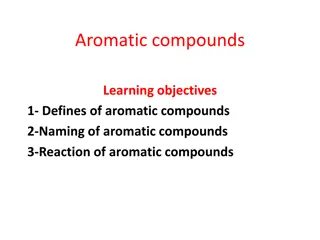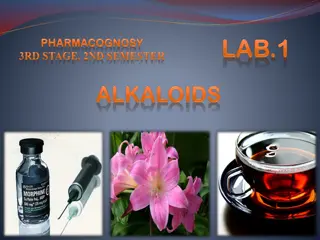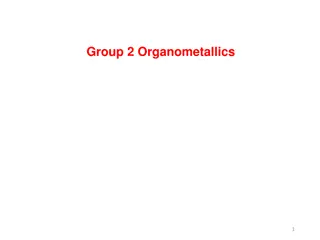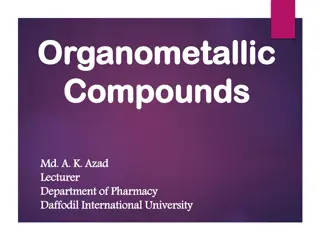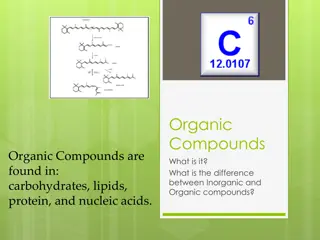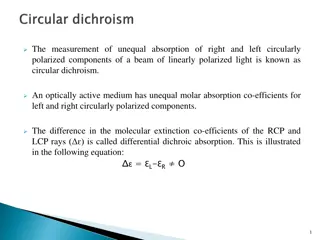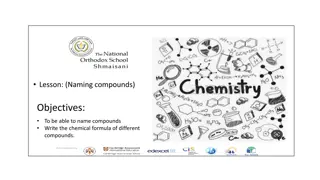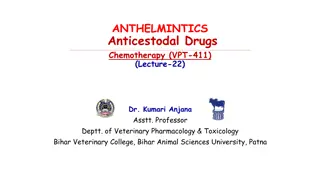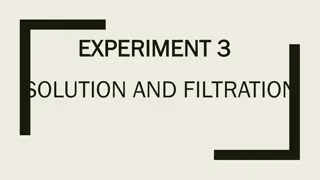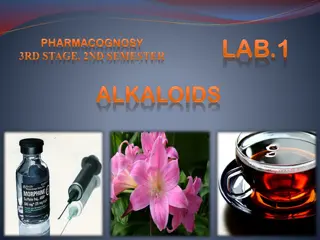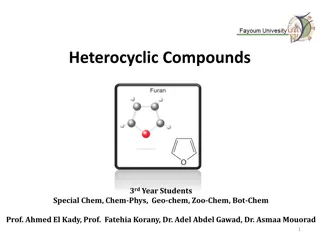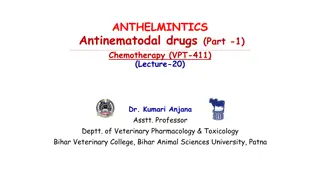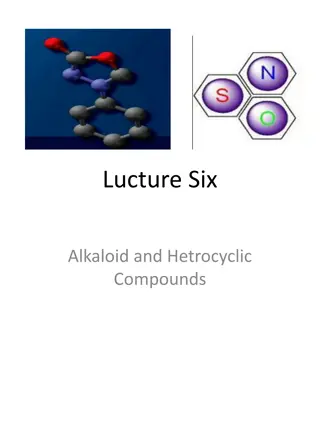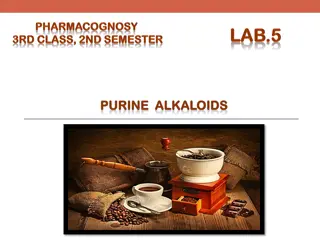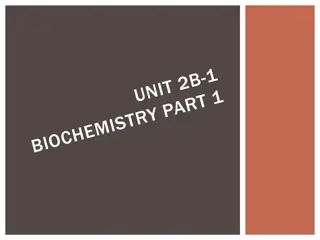Heterocyclic Compounds: Pyrrole and Its Properties
Heterocyclic compounds, such as pyrrole, are vital in natural products and pharmaceutical chemistry. Explore the structure, preparation, properties, and uses of pyrrole, an essential compound in various industries.
Download Presentation

Please find below an Image/Link to download the presentation.
The content on the website is provided AS IS for your information and personal use only. It may not be sold, licensed, or shared on other websites without obtaining consent from the author.If you encounter any issues during the download, it is possible that the publisher has removed the file from their server.
You are allowed to download the files provided on this website for personal or commercial use, subject to the condition that they are used lawfully. All files are the property of their respective owners.
The content on the website is provided AS IS for your information and personal use only. It may not be sold, licensed, or shared on other websites without obtaining consent from the author.
E N D
Presentation Transcript
Structureactivity relationship (SAR) Structure activity relationship studies are usually carried out by making minor changes to the structure of a lead to produce analogues and assessing the effect that these structural changes have on biological activity. The investigation of numerous lead compounds and their analogues has made it possible to make some broad generalisations about the biological effects of specific types of structural changes.
These changes may be conveniently classified as changing: the size and shape of the carbon skeleton the nature and degree of substitution the stereochemistry of the lead
Changing size and shape The shapes and sizes of molecules can be modified in a variety of ways, such as: changing the number of methylene groups in chains and rings increasing or decreasing the degree of unsaturation introducing or removing a ring system
Changing the number of methylene groups in chains and rings Increasing the number of methylene groups in a chain or ring increases the size and the lipophilicity of the compound. It is believed that any increase in activity with increase in the number of methylene groups is probably due to an increase in the lipid solubility of the analogue, which gives a better membrane penetration. Conversely, a decrease in activity with an increase in the number of methylene groups is attributed to a reduction in the water solubility of the analogues. This reduction in water solubility can result in the poor distribution of the analogue in the aqueous media as well as the trapping of the analogue in biological membranes.
Introducing chain branching, different sized rings and the substitution of chains for rings, and vice versa, may also have an effect on the potency and type of activity of analogues. For example, the replacement of the sulphur atom of the antipsychotic chlorpromazine by - CH2-CH2- produces the anti depressant clomipramine.
Changing the degree of unsaturation The removal of double bonds increases the degree of flexibility of the molecule, which may make it easier for the analogue to fit into active and receptor sites by taking up a more suitable conformation. However, an increase in flexibility could also result in a change or loss of activity. The introduction of a double bond increases the rigidity of the structure. It may also introduce the complication of E and Z isomers, which could have quite different activities.The analogues produced by the introduction of unsaturated structures into a lead compound may exhibit different degrees of potency or different types of activities.
For example, the potency of prednisone is about 30 times greater than that of its parent compound cortisol, which does not have a 1 2 C=C bond. The replacement of the S atom of the antipsychotic phenothiazine drugs by a CH=CH- group gives the antidepressant dibenzazepine drugs, such as protriptyline.
The introduction of a C=C group will often give analogues that are more sensitive to metabolic oxidation. This may or may not be a desirable feature for the new drug. Furthermore, the reactivity of the C=C frequently causes the analogue to be more toxic than the lead.
Introduction or removal of a ring system The introduction of a ring system changes the shape and increases the overall size of the analogue. The effect of these changes on the potency and activity of the analogue is not generally predictable. However, the increase in size can be useful in filling a hydrophobic pocket in a target site, which might strengthen the binding of the drug to the target.
For example, it has been postulated that the increased inhibitory activity of the cyclopentyl analogue (rolipram) of 3-(3,4-dimethyloxyphenyl)-butyrolactam towards cAMP phosphodiesterase is due to the cyclopentyl group filling a hydrophobic pocket in the active site of this enzyme.
The incorporation of smaller, as against larger, alicyclic ring systems into a lead structure reduces the possibility of producing an analogue that is too big for its target site. It also reduces the possibility of complications caused by the existence of conformers. However, the selection of the system for a particular analogue may depend on the objective of the alteration. For example, the antidepressant tranylcypromine is more stable than its analogue 1-amino-2-phenylethene.
The insertion of aromatic systems into the structure of the lead will introduce rigidity into the structure as well as increase the size of the analogue. The latter means that small aromatic systems such as benzene and five-membered heterocyclic systems are often preferred to larger systems. However, the p electrons of aromatic systems may or may not improve the binding of the analogue to its target site. Furthermore, heterocyclic aromatic systems will also introduce extra functional groups into the structure, which could also affect the potency and activity of the analogue.
For example, the replacement of the N- dimethyl group of chlorpromazine by an N- methylpiperazine group produces an analogue (prochlorperazine) with increased antiemetic potency but reduced neuroleptic activity. It has been suggested that this change in activity could be due to the presence of the extra tertiary amine group.
The incorporation of ring systems, especially larger systems, into the structure of a lead can be used to produce analogues that are resistant to enzymic attack by sterically hindering the access of the enzyme to the relevant functional group.
For example, the resistance of diphenicillin to -lactamase is believed to be due to the diphenyl group preventing the enzyme from reaching the -lactam. It is interesting to note that 2-phenylbenzylpenicillin is not resistant to -lactamase attack. In this case, it appears that the diphenyl group is too far away from the -lactam ring to hinder the attack of the --lactamase.
Introduction of new substituents The formation of analogues by the introduction of new substituents into the structure of a lead may result in an analogue with significantly different chemical and hence different pharmacokinetic properties. For example, the introduction of a new substituent may cause significant changes in lipophilicity, which affect transport of the analogue through membranes and the various fluids found in the body. It would also change the shape, which could result in conformational restrictions that affect the binding to target site. In addition the presence of a new group may introduce a new metabolic pathway for the analogue. These changes will in turn affect the pharmacodynamic properties of the analogue.
For example, they could result in an analogue with either increased or decreased potency duration of action, metabolic stability and unwanted side effects. The choice of substituent will depend on the properties that the development team decide to enhance in an attempt to meet their objectives. Each substituent will impart its own characteristic properties to the analogue. However, it is possible to generalise about the effect of introducing a new substituent group into a structure but there will be numerous exceptions to the predictions.
Methyl groups The introduction of methyl groups usually increases the lipophilicity of the compound and reduces its water solubility as shown by an increase in the value of the partition coefficient (Table). It should improve the ease of absorption of the analogue into a biological membrane but will make its release from biological membranes into aqueous media more difficult. The introduction of a methyl group may also improve the binding of a ligand to its receptor by filling a pocket on the target site.
Table The change in the partition coefficients (P) of some common compounds when methyl groups are introduced into their structures. The greater the value of P the more lipid soluble the compound. Benzene and toluene values were measured using an n-octanol/water system whilst the remaining values were measured using an olive oil/water system.
The incorporation of a methyl group can impose steric restrictions on the structure of an analogue.
For example, the ortho-methyl analogue of diphenhydramine exhibits no antihistamine activity. Harmes et al. suggest this to be due to the ortho- methyl group restricting rotation about the C O bond of the side chain. This prevents the molecule adopting the conformation necessary for antihistamine activity. It is interesting to note that the para-methyl analogue is 3.7 times more active than diphenhydramine
The incorporation of a methyl group can have one of three general effects on the rate of metabolism of an analogue. It can result in either (1) an increased rate of metabolism due to oxidation of the methyl group, (2) an increase in the rate of metabolism due to demethylation by the transfer of the methyl group to another compound or (3) a reduction in the rate of metabolism of the analogue.
1. A methyl group bound to an aromatic ring or a structure may be metabolised to a carboxylic acid, which can be more easily excreted. For example, the antidiabetic tolbutamide is metabolised to its less toxic benzoic acid derivative. The introduction of a reactive C CH3 group offers a detoxification route for lead compounds that are too toxic to be of use.
2. Demethylation is more likely to occur when the methyl group is attached to positively charged nitrogen and sulphur atoms, although it is possible for any methyl group attached to a nitrogen, oxygen or sulphur atom to act in this manner. A number of methyl transfers have been associated with carcinogenic action. 3. Methyl groups can reduce the rate of metabolism of a compound by masking a metabolically active group, thereby giving the analogue a slower rate of metabolism than the lead.
For example, the action of the agricultural fungicide nabam is due to it being metabolised to the active diisothiocyanate. N-Methylation of nabam yields an analogue that is in active because it cannot be metabolised to the active diisothiocyanate.
Methylation can also reduce the unwanted side effects of a drug. For example, mono-and di- ortho-methylation with respect to the phenolic hydroxy group of paracetamol produces analogues with reduced hepatotoxicity. It is believed that this reduction is due to the methyl groups preventing metabolic hydroxylation of these ortho positions.
Larger alkyl groups will have similar effects. However, as the size of the group increases the lipophilicity will reach a point where it reduces the water solubility to an impractical level. Consequently, most substitutions are restricted to methyl and ethyl groups.
Halogen groups The incorporation of halogen atoms into a lead results in analogues that are more lipophilic and so less water soluble. Consequently, halogen atoms are used to improve the penetration of lipid membranes. However, there is an undesirable tendency for halogenated drugs to accumulate in lipid tissue. The chemical reactivity of halogen atoms depends on both their point of attachment to the lead and the nature of the halogen. Aromatic halogen groups are far less reactive than aliphatic halogen groups, which can exhibit considerable chemical reactivity. The strongest and least reactive of the aliphatic carbon halogen bonds is the C F bond. It is usually less chemically reactive than aliphatic C H bonds. The other aliphatic C halogen bonds are weaker and so more reactive, their reactivity increasing as one moves down the periodic table. They are normally more chemically reactive than aliphatic C H bonds.
Consequently, the most popular halogen substitutions are the less reactive aromatic fluorine and chlorine groups. However, the presence of electron withdrawing ring substituents may increase their reactivity to unacceptable levels. Trifluorocarbon groups (-CF3) are sometimes used to replace chlorine as these groups are of a similar size. These substitutions avoid introducing a very reactive centre and hence a possible site for unwanted side reactions into the analogue. For example, the introduction of the more reactive bromo group can cause the drug to act as an alkylating agent.
Hydroxyl groups The introduction of hydroxyl groups into the structure of a lead will normally produce analogues with an increased hydrophilic nature and a lower lipid solubility. It also provides a new centre for hydrogen bonding, which could influence the binding of the analogue to its target site. For example, the ortho-hydroxylated minaprine analogue binds more effectively to M1-muscarinic receptors than many of its non-hydroxylated analogues.
The introduction of a hydroxy group also introduces a centre that, in the case of phenolic groups, could act as a bacterioside, whilst alcohols have narcotic properties. However, the presence of hydroxy groups opens a new metabolic pathway that can either act as a detoxification route or prevent the drug reaching its target.
Basic groups The basic groups usually found in drugs are amines, including some ring nitrogen atoms, amidines and guanidines. All these basic groups can form salts in biological media. Consequently, incorporation of these basic groups into the structure of a lead will produce analogues that have a lower lipophilicity but an increased water solubility. This means that the more basic an analogue, the more likely it will form salts and the less likely it will be transported through a lipid membrane
The incorporation of aromatic amines into the structure of a lead is usually avoided since aromatic amines are often very toxic and are often carcinogenic.
Carboxylic and sulphonic acid groups The introduction of acid groups into the structure of a lead usually results in analogues with an increased water but reduced lipid solubility. This increase in water solubility may be subsequently enhanced by in vivo salt formation. In general the introduction of carboxylic and sulphonic acid groups into a lead produces analogues that can be more readily eliminated (see Table 12.2). The introduction of carboxylic acid groups into small lead molecules may produce analogues that have a very different type of activity or are inactive. For example, the introduction of a carboxylic acid group into phenol results in the activity of the compound changing from being a toxic antiseptic to the less toxic anti-inflammatory salicylic acid.
Similarly, the incorporation of a carboxylic acid group into the sympathomimetic phenylethylamine gives phenylalanine, which has no sympathomimetic activity. However, the introduction of carboxylic acid groups appears to have less effect on the activity of large molecules. Sulphonic acid groups do not usually have any effect on the biological activity but will increase the rate of excretion of an analogue.
Thiols, sulphides and other sulphur groups Thiol and sulphide groups are not usually introduced into leads in SAR studies because they are readily metabolised by oxidation (see Table 12.1). However, thiols are sometimes introduced into a lead structure when improved metal chelation is the objective of the SAR study. For example, the antihypertensive captopril was developed from the weakly active carboxyacylprolines by replacement of their terminal carboxylic acid group with a thiol group, which is a far better group for forming complexes with metals than carboxylic acids. The introduction of thiourea and thioamide groups is usually avoided since these groups may produce goitre, a swelling on the neck due to enlargement of the thyroid gland.
Changing the existing substituents of a lead Analogues can also be formed by replacing an existing substituent in the structure of a lead by a new substituent group. The choice of group will depend on the objectives of the design team. It is often made using the concept of isosteres. Isosteres are groups that exhibit some similarities in their chemical and/or physical properties. As a result, they can exhibit similar pharmacokinetic and pharmacodynamic properties. In other words, the replacement of a substituent by its isostere is more likely to result in the formation of on analogue with the same type of activity as the lead than the totally random selection of an alternative substituent. However, luck still plays a part and an isosteric analogue may have a totally different type of activity from its lead.
Classical isosteres were originally defined by Erlenmeyer as being atoms, ions and molecules which had identical outer shells of electrons. This definition has now been broadened to include groups that produce compounds that can sometimes have similar biological activities.These groups are frequently referred to as bioisosteres in order to distinguish them from classical isosteres.
A large number of drugs have been discovered by isosteric and bioisosteric interchanges. For example, the replacement of the 6-hydroxy group of hypoxanthine by a thiol group gave the anti tumour drug 6-mercaptopurine whilst the replacement of hydrogen in the 5-position of uracil by fluorine resulted in fluorouracil, which is also an anti tumour agent. However, not all isosteric changes yield compounds with the same type of activity: the replacement of the - S- of the neuroleptic phenothiazine drugs by either -CH CH- or -CH2CH2- produces the dibenzazepines, which exhibit antidepressant activity.
Table- Examples of bioisosteres. Each horizontal row represents a group of structures that are isosteric.
Figure- Examples of drugs discovered by isosteric replacement
Drug and analogue synthesis Starting materials The choice of starting materials is important in any synthetic route. Common sense dictates that they should be chosen on the basis of what will give the best chance of reaching the desired product. Furthermore, in all cases the starting materials should be cheap and readily available. However this is not always possible when carrying out the initial synthesis of a specific analogue. The job of the process chemist is to convert these expensive analogue syntheses into more viable manufacturing methods.
Practical considerations The chemical reactions selected for the proposed synthetic pathway will obviously depend on the structure of the target compound. However, a number of general considerations need to be borne in mind when selecting these reactions: 1. The yields of reactions should be high. This is particularly important when the synthetic pathway involves a large number of steps. 2. The products should be relatively easy to isolate, purify and identify. 3. Reactions should be stereospecific as it is often difficult and expensive to separate enantiomers. However, the exclusive use of stereospecific reactions in a synthetic pathway is a condition that is often difficult to satisfy. 4. The reactions used in the research stage of the synthesis should be adaptable to large scale production methods. The reactions used by research workers frequently use expensive exotic reagents and it is the job of pharmaceutical development chemists to find simpler cost-effective alternatives.
The overall design All approaches are based on a knowledge of the chemistry of functional groups and their associated carbon skeletons. The design may result in either a linear synthesis, where one step in the pathway is immediately followed by another: A -> B -> C-> D-> to the target molecule
or a convergent synthesis, where two or more sections of the molecule are synthesised separately before being combined to form the target structure.In both cases, the disconnection approach may be used to design the pathway and identify suitable starting materials. Alternative design strategies that can also be usefully employed to design a synthesis are: finding compounds with similar structures to the target molecule and modifying their synthetic routes, if known, to produce the target compound modifying natural products whose structures contain the main part of the target structure
The use of protecting groups The design of synthetic pathways often requires a reaction to be carried out at one centre in a molecule, the primary process, whilst preventing a second centre from either interfering with the primary process or undergoing a similar unwanted reaction. This objective may be achieved by careful choice of reagents and reaction conditions. However, an alternative is to combine the second centre with a so-called protecting group to form a structure that cannot react under the prevailing reaction conditions. A protecting group must be easy to attach to the relevant functional group, forma stable structure that is not affected by the reaction conditions and reagents being used to carry out the primary process and should be easily removed once it is no longer required (Table 15.1). However, in some circumstances, protecting groups may not be removed but converted into another structure as part of the synthesis.
Table- Examples of protecting groups. The conditions used will vary and so only the principal reagents are shown.


